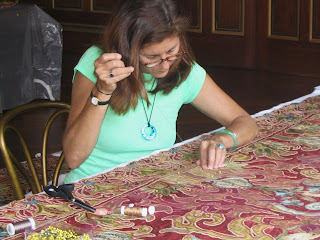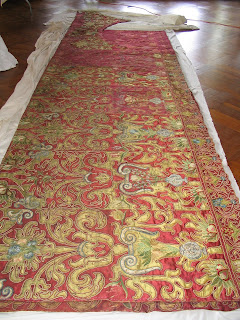Tuesday, July 23, 2013 -  ARCA alum,conservation,Julia Brennan,textiles,Turkey
ARCA alum,conservation,Julia Brennan,textiles,Turkey
 No comments
No comments
 ARCA alum,conservation,Julia Brennan,textiles,Turkey
ARCA alum,conservation,Julia Brennan,textiles,Turkey
 No comments
No comments
Work of textile conservator Julia Brennan (ARCA '09) featured in new book on "The Turkish Ambassador's Residence and the Cultural History of Washington, D.C."
WASHINGTON, D.C. -- The work of textile conservator Julia Brennan (ARCA '09) is one of the many features in the recently published book by Istanbul Kültür University, The Turkish Ambassador's Residence and the Cultural History of Washington, D.C., authored by Skip Moskey, Caroline Mesrobian Hickman, and John Edward Hasse.
Here are link's to Ms. Brennan's posts in 2011 on the Everett's House Ottoman-style wall fabrics in the ballroom and the project to conserve them.
The residence of the Turkish Ambassador in the American capital is a early 20th century mansion (1910-1915) buildt by Ohio-industrialist Edward Hamlin Everett (1851-1929) and designed by George Oakley Totten, Jr. The Turkish government purchased the home during the Great Depression and undertook a restoration of the residence between 2001 and 2007 under the direction of interior designer Aniko Gaal Schott and architect Belinda Reeder.
Mr. Skip Moskey writes on the 'intersection of politics, architecture, and social structure in the early history of Washington' and used primary research materials to write about Edward Hamlin Everett. Ms. Caroline Hickman wrote about the architect Totten and the interior decoration of the house using diplomatic records in the national Archives. John Edward Hasse documents the musical history of the residence, once the childhood home of the co-founder of Atlantic Records:
An important chapter in the history of the house was the decade between 1934 and 1944, when the sons of Ambassador and Mrs. Mehmet Münir Ertegün, Ahmet and Nesuhi, brought noted African-American musicians home for jazz sessions in the Embassy. There they broke racial barriers and enriched Washington's music scene through their passion for African-American music.
Ms. Brennan worked on the cleaning and conservation of the embroidered and appliqué silk architectural textiles that decorate the upper sections of the ballroom walls, as she describes here:
an extraordinary complex technique of appliqué of silk sateen cutouts (think matisse) on top of contrasting silk sateen ground, with each motif outlined with a cording that was stitched and glued on. The pattern, an architectural niche containing a tall bulbous 'vase' shape, alternates the red and gold silk, so the eye moves along as if following a series of decorative windows.YouTube has a series of videos on the book launching at the Turkish residence in early July, including a discussion by Ms. Caroline Mesrobian Hickman.




















